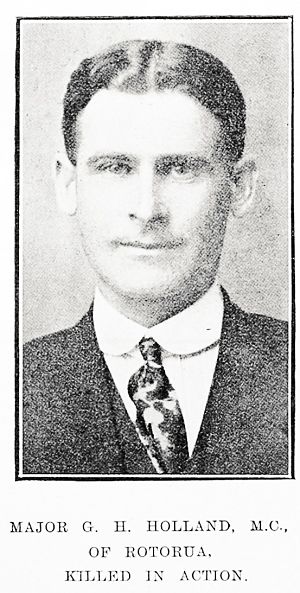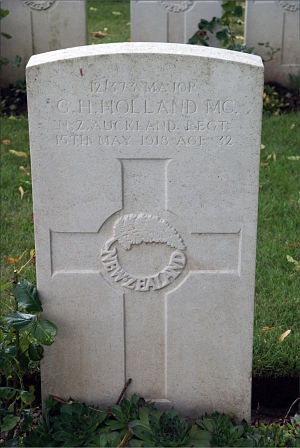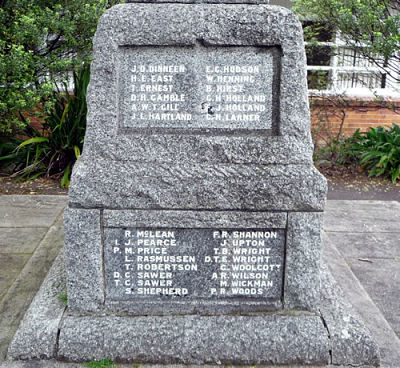WW1 Major George Henry Holland M.C. (Service Number 12/373)
George Holland was born on 12 July 1885 in Onewhero, South Auckland, the older son of John and Emily Holland of Tuakau, Waikato, New Zealand.
They later moved to 20 Station Road (now Ohinerau St), Remuera, Auckland. George’s younger brother Frederick John Holland (Service number 57847) also fought and died in World War I and his sister who became Mrs J. Baker lived at The Drive, Epsom. [1]
George worked as an Agent for the RM company in Rotorua. In the 1900s the company was called Edwin Robertson’s Coaching Company, which had been taken over in 1903 and became the Rotorua Motor Coaching Company or RM Company. The condition of the roads between 1910-1919 was of greater concern for those using motor vehicles than it was for horse-drawn vehicles. Later, the company became the Rotorua Motor Transport Company, then New Zealand Road Services servicing the central North Island. [2, 3]
George was a volunteer in the Territorials ‘A’ Squad of the Auckland Mounted Rifles. He resigned his commission on 2 May 1912 because his business pressures did not allow time to do justice to the position. He was the Honorary Secretary and Treasurer of the Rotorua Hockey Association and involved in refereeing at local and competition level such as in the annual competitions for the White Horse Cup, a cup presented by the White Horse Whiskey Company. The White Horse Company also presented cups to other sports, such as Rugby and Rowing, for their competitions. [4, 5] George was involved in the Poultry, Pigeon and Canary Society and in 1913 won second prizes in the Cockerel category and the Pullet category. [6]
When he enlisted on 15 August 1914, George was 5ft 8 inches tall, had blue eyes and brown hair. George sailed on the 16 October 1914- from Wellington and arrived on 3 December 1914 in Suez, Egypt on the vessel ‘Star of India’ or ‘Waimana’ as a Private with the Main Body of the Auckland Infantry Battalion. Whilst on the ship George spent a short time in hospital with measles. He was hospitalised again with pneumonia in March 1915 in Egypt. He was posted to Gallipoli and was awarded the Military Cross:
For invaluable services rendered during the whole time between the landing and the evacuation. September – December 1915 Gallipoli Peninsula. [7]
A letter written by George on 20 September 1915, was published in the New Zealand Herald 30 November 1915 about his time in Gallipoli. He was a Lieutenant at the time and in command of his company doing a Major’s works as most of the other officers were invalids:
“The New Zealand brigade was withdrawn from the trenches last Tuesday night, and was brought here to the Sarpi Rest Camp, West Mudros, for a month’s rest.” says Lieutenant G. H. Holland, of the North Auckland Company, writing on September 20. “We do two hours’ drill daily, just to keep the men fit.”
“I landed on Gallipoli at Cape Helles on May 8 (1915),” proceeds the lieutenant, “and took part in the charge when the New Zealand troops lost heavily. My next charge was at Quinn’s Post, on June 4, and was most exciting. We left our trenches at 11 p.m., and rushed the Turks trench. A number of our men carried bombs and drove a number of the Turks out. Then they got to work with the bayonet, and accounted for quite a number, besides taking 36 prisoners. We then got to work with what little material there was and began to build bomb-proof shelters. At daybreak the Turks started bombing in real earnest, and where we were, was a veritable Hades. We were driven out of the trench at 8 a.m., our casualties being 110 killed and wounded. Captain Algie, Captain Brown, a private from the l5th Company, and I were the last to leave the trench, and we carried out two men who were badly wounded. We took up a position in a blockhouse, and were relieved at 10 a.m.
“My next charge was on the night of June 7, when we tried to take the same trench. But the Turks were prepared for us, .and had plenty of machine-guns and bombs. Our casualties were 57 killed, wounded, and missing out of 70. I was knocked senseless by a bomb but was able to carry on next day.
“My next charge was at 11 a.m. on August 7, when my platoon, consisting of 30 all told, was ordered to go forward and take the first trench, near Chanak Bair. We were all very tired, but we went forward at a fair pace, and captured the trench, but we lost half our men. We were immediately reinforced, and by dusk had 99 of all ranks in the trench. We had to do a lot of work in the way of deepening the trench and putting up sandbags. We were relieved by the Tommies at 10 p.m. on the Monday and were not sorry. The men were nearly played out.
“We took up a position on the left, and the following day we accounted for quite a number of Turks, who tried to reach us, but were shot down. So far, I have had a charmed life, and I hope my luck will stick to me when I return to the firing-lines.” [8]
He was posted to the Western front in 6 April 1916, returned to England on the 8 July 1917 for two months for training at Divisional Training School. On 13 July 1916, he was Mentioned in Despatches:
For distinguished and gallant services rendered during the period of General Sir Charles. Munro’s command of the Mediterranean Expeditionary Force 10 April 1916. [9]
General Sir Charles Munro had successfully organised the evacuation of the soldiers from Gallipoli successfully in December 1915 – January 1916 without any further causalities.
George was promoted to Captain on 1st March 1916 and then to Major on 4 December 1916 which was confirmed on 3 May 1917. He was then posted to France on 12th September 1917 with units fighting towards the capture of territory on the Western Front and the Somme. George was killed in action on 15 May 1918 aged 32, a week after his brother Frederick was killed.
George is buried Euston Road Cemetery, Colincamps, Somme, France, IV.K. Major George Henry Holland was awarded:
• Military Cross
• Mentioned in Despatches (MID)
• 1914-1915 Star, British War Medal (1914-1920),
• Victory Medal with oak leaf (denoting he was mentioned in despatches)
He is remembered on the memorials at:
• St Aidan’s Church, Remuera, Auckland
• Rotorua War Memorial (World War I), Rotorua
• Roll of Honour, Tuakau, WW1 1914 – 1918, Tuakau Memorial Hall, George Street, Tuakau, Waikato, New Zealand
• Tuakau War Memorial, Tuakau Services Cemetery, Corner of Alexandra, Redoubt, Roberts Roads, Tuakau, Waikato, New Zealand


